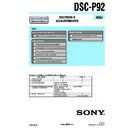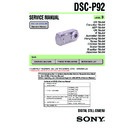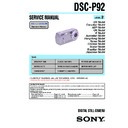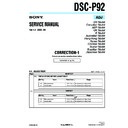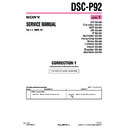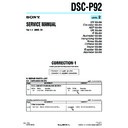Sony DSC-P92 (serv.man4) Service Manual ▷ View online
6-39
DSC-P92
6-2. SERVICE MODE
2-1.
APPLICATION FOR ADJUSTMENT (SEUS)
The application for adjustment (SEUS) is used for changing the
calculation coefficient in signal processing, EVR data, etc. The SEUS
performs bi-directional communication between the personal
computer (PC) and the unit using the USB signal. The resultant
data of this bi-directional communication is written in the non-
volatile memory.
calculation coefficient in signal processing, EVR data, etc. The SEUS
performs bi-directional communication between the personal
computer (PC) and the unit using the USB signal. The resultant
data of this bi-directional communication is written in the non-
volatile memory.
2-1-1.
Using Method of SEUS
1. Connection
1)
1)
Connect the HASP key to the USB port of the PC.
2)
Connect the camera to another USB port of the PC.
3)
Insert a memory stick to the camera.
4)
Confirm that the camera starts in the USB mode.
5)
Start the SEUS on the PC.
6)
Click [Connect] on the SEUS screen. If the connection is
normal, the SEUS screen will be as shown in Fig. 6-2-1,
indicating the “connected” state.
normal, the SEUS screen will be as shown in Fig. 6-2-1,
indicating the “connected” state.
Note: The SEUS will go in “disconnect” state, if the camera is turned
off (for instance, by resetting the unit). In such a case, click
[Connect] on the SEUS screen to restore the “connected” state.
[Connect] on the SEUS screen to restore the “connected” state.
Fig. 6-2-1
2. Operation
• Page change
To change the page, click [Page] on the SEUS screen and enter
the page to be changed. The page is displayed in hexadecimal
notation.
the page to be changed. The page is displayed in hexadecimal
notation.
• Address change
To change the address, click [Address] on the SEUS screen and
enter the address to be changed. Or click [B] to increase the
address, click [b] to decrease the address. The address is displayed
in hexadecimal notation.
enter the address to be changed. Or click [B] to increase the
address, click [b] to decrease the address. The address is displayed
in hexadecimal notation.
• Data change
To change the data, click [Set] on the SEUS screen and enter the
data. Or click [v] to increase the data, click [V] to decrease the
data. The data is displayed in hexadecimal notation.
This operation does not write the data to the nonvolatile memory.
If you want to write the changed data, click [Store] to write it.
data. Or click [v] to increase the data, click [V] to decrease the
data. The data is displayed in hexadecimal notation.
This operation does not write the data to the nonvolatile memory.
If you want to write the changed data, click [Store] to write it.
• Data writing
To write the data to the nonvolatile memory, click [Write] on the
SEUS screen and enter the data to be written.
SEUS screen and enter the data to be written.
• Data reading
The data displayed on the SEUS screen are the data values at the
time when the pages and addresses were set, and they are not
updated automatically. To check the data change, click [Read] on
the SEUS screen and update the displayed data.
time when the pages and addresses were set, and they are not
updated automatically. To check the data change, click [Read] on
the SEUS screen and update the displayed data.
2-1-2.
Precaution on Use of SEUS
Mishandling of the SEUS may erase the correct adjustment data at
times. To prevent this, it is recommended that all adjustment data
be saved before beginning adjustments.
times. To prevent this, it is recommended that all adjustment data
be saved before beginning adjustments.
1)
Click [Page Edit] on the SEUS screen.
2)
Click [Page], and enter the page number to be saved.
3)
Click [Read] to read the data to be saved from the camera.
4)
Click [File] and save the data.
COVER
COVER
6-40
DSC-P92
2-2.
SERVICE MODE
1. Setting the Test Mode
Page 2F
Address 21
Data
Function
00
Normal
02
Forced MOVIE mode power ON
03
Forced STILL mode power ON
04
Forced PLAY mode power ON
• Before setting the data, select page: 00, address: 01, and set data:
01.
• For page 2F, the data set is recorded in the non-volatile memory
by clicking [Write] button. In this case, take note that the test
mode will not be exited even when the main power is turned off.
mode will not be exited even when the main power is turned off.
• After completing adjustments/repairs, be sure to return the
data of this address to “00”, and press [Write] button.
Select page: 00, address: 01, and set data: 00.
Select page: 00, address: 01, and set data: 00.
2. Bit value discrimination
Bit values must be discriminated using the hexadecimal data for
following items. Use the table below to discriminate if the bit value
is “1” or “0”.
Bit values must be discriminated using the hexadecimal data for
following items. Use the table below to discriminate if the bit value
is “1” or “0”.
Examples: If the hexadecimal data is “8E”, the bit values for bit7 to bit4
are shown in the A column, and the bit values for bit3 to bit0
are shown in the B column.
are shown in the B column.
bit3 to bit0 discrimination
bit7 to bit4 discrimination
Hexadecimal data
Display on the
adjustment
remote
commander
0
1
2
3
4
5
6
7
8
9
A (
A
)
B (
b
)
C (
c
)
D (
d
)
E (
E
)
F (
F
)
Bit values
bit3
or
bit7
0
0
0
0
0
0
0
0
1
1
1
1
1
1
1
1
bit2
or
bit6
0
0
0
0
1
1
1
1
0
0
0
0
1
1
1
1
bit1
or
bit5
0
0
1
1
0
0
1
1
0
0
1
1
0
0
1
1
bit0
or
bit4
0
1
0
1
0
1
0
1
0
1
0
1
0
1
0
1
A
B
COVER
COVER
6-41
DSC-P92
3. Switch check (1)
Page 20
Address 80
Function
POWER switch (XPWER ON)
(Control switch block (RL-059) S002)
Shutter button (XSHTR ON SW)
(Control switch block (RL-059) S003)
Shutter button (XAE LOCK SW)
(Control switch block (RL-059) S003)
When bit value=1
OFF
OFF
OFF
When bit value=0
ON
ON
ON
Using method:
1)
1)
Select page: 20, address: 80.
2)
Read the data. By discriminating the bit value of the data, the state of the switches can be discriminated.
Bit
0
1
2
3
4
4. Switch check (2)
Page 20
Address 90 to 92, 94
Using method:
1)
1)
Select page: 20, address: 90 to 92, 94.
2)
Read the data. By discriminating the data, the pressed key can be discriminated.
Address
90
(MODE DIAL1)
(IC401 tf)
91
(KEY AD0)
(IC401 tg)
92
(KEY AD1)
(IC401 th)
94
(KEY AD3)
(IC401 tk)
00 to 0C
Mode dial
SET UP
(SW-391 block)
Control button
DOWN (S104)
(SW-391 block)
Control button
RIGHT (S105)
(SW-391 block)
ZOOM WIDE
(S102)
(SW-391 block)
0D to 27
Mode dial
MOVIE
(SW-391 block)
Control button
UP (S100)
(SW-391 block)
Control button
LEFT (S101)
(SW-391 block)
ZOOM TELE
(S106)
(SW-391 block)
28 to 48
Mode dial
STILL
(SW-391 block)
MENU
(S107)
(SW-391 block)
Control button
SET (S103)
(SW-391 block)
49 to 73
Mode dial
PLAY
(SW-391 block)
IMAGE SIZE/
DELETE (S110)
(SW-391 block)
LCD STATUS/
LCD ON-OFF (S108)
(SW-391 block)
(SW-391 block)
DD to FF
No key input
No key input
No key input
No key input
Data
5. LED check
Page 20
Address 04
Using method:
1)
1)
Select page: 20, address: 04, set data: 02.
2)
Check that all LED (TALLY/ACCESS LED, AE LOCK/FLASH LED, STROB/CHARGE LED, MS LED) are lit.
3)
Select page: 20, address: 04, set data: 00.
6. Record of Use check
Page 4F
Address AD to AF
Using method:
1)
1)
The recording counter data is displayed at page: 4F, addresses: AC to AF. These data are named D
AC
, D
AD
, D
AE
and D
AF
respectively.
2)
Calculate the recording counter (N) using following equation. (Hexadecimal calculation)
N = D
AF
+ D
AE
×
100 + D
AD
×
10000 + D
AC
×
1000000
Address
AC
AD
AE
AF
Function
Recording counter
(Hexadecimal)
Remarks
1000000 – digit and 1000000 – digit
1000000 – digit and 10000 – digit
1000 – digit and 100 – digit
10 – digit and 1 – digit
✂
✂
〈
FOR CAMERA COLOR REPRODUCTION ADJUSTMENT
〉
Take a copy of CAMERA COLOR
REPRODUCTION FRAME with
a clear sheet for use.
REPRODUCTION FRAME with
a clear sheet for use.
DSC-P92
6-42E
〈
AF ILLUMINATION FRAME
〉

